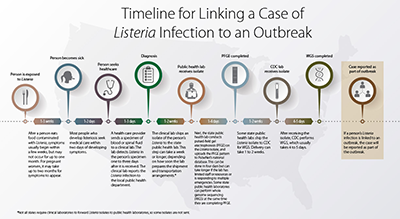Surveillance
Surveillance provides valuable insights into the foods, germs, and settings linked to foodborne diseases. For more than 30 years, CDC has conducted surveillance for Listeria infections to learn more about the germ, how it causes disease, how it’s spread, and other information to help protect the public from illness. Each of the CDC systems monitoring Listeria serves a different purpose. Together, they provide a comprehensive view of listeriosis in the United States.
The Listeria Initiative
The Listeria Initiative is an enhanced surveillance system that collects reports of laboratory-confirmed cases of listeriosis in the United States. Its goal is to find and stop outbreaks by interviewing all patients with Listeria infection using the Listeria Case Report, a questionnaire developed to collect detailed information about the foods people ate before they got sick. The information collected from patients on the Listeria Case Report helps identify foods that may be contaminated with Listeria.
- Learn more about the Listeria Initiative
- Download the English version of the Listeria Case Report form [PDF – 15 pages]
- Download the Spanish version of the Listeria Case Report form [PDF – 15 pages]
Foodborne Diseases Active Surveillance Network (FoodNet)
FoodNet collects information to track rates and report trends for nine germs transmitted commonly by food, including Listeria. FoodNet is a collaborative program among the Centers for Disease Control and Prevention, 10 state health departments, the U.S. Department of Agriculture’s Food Safety and Inspection Service, and the Food and Drug Administration.
PulseNet
PulseNet connects foodborne illness cases by using DNA fingerprints of the bacteria making people sick.
When PulseNet identifies a possible cluster of Listeria by finding the same molecular pattern in patients’ samples, epidemiologists can rapidly investigate the source. PulseNet has added a new, more precise testing method, whole genome sequencing, to find more outbreaks and help stop them while small.
National Notifiable Diseases Surveillance System (NNDSS)
The National Notifiable Diseases Surveillance System (NNDSS) is a reporting system that enables all local, state, territorial, and federal health agencies to share health information to monitor, control, and prevent the occurrence and spread of nationally notifiable infectious diseases, including listeriosis, and some noninfectious diseases and conditions.
Foodborne Disease Outbreak Surveillance System (FDOSS)
The Foodborne Disease Outbreak Surveillance System (FDOSS) collects reports of foodborne disease outbreaks from local, state, tribal, and territorial public health agencies. FDOSS contains information on foods, settings, and germs linked to specific outbreaks.
Surveillance Summaries
- Listeria Initiative Surveillance Overview [PDF – 2 pages]
- Listeria Annual Summary 2014 [PDF – 8 pages]
- Listeria Annual Summary 2013 [PDF – 8 pages]
- Listeria Annual Summary 2012 [PDF – 9 pages]
- Listeria Annual Summary 2011 [PDF – 7 pages]
- Listeria Annual Summary 2010 [PDF – 5 pages]
- Listeria Annual Summary 2009 [PDF – 5 pages]
- Listeria Annual Summary 2008 [PDF – 5 pages]
- Listeria Annual Summary 2007 [PDF – 5 pages]
Solving Outbreaks

We’re using real-time whole genome sequence-based Listeria surveillance to solve outbreaks and improve food safety.
How Long Can It Take to Link a Case of Listeriosis to an Outbreak?

Have you ever wondered why it takes a while to hear about cases of Listeria infection after a person gets sick? Or why the number of cases linked to an outbreak can increase for weeks after measures are taken to stop the outbreak? A series of events occurs from when someone eats a food contaminated with Listeria to when public health officials can determine that the person is part of an outbreak. Find out more
- Page last reviewed: December 12, 2016
- Page last updated: June 29, 2017
- Content source:


 ShareCompartir
ShareCompartir